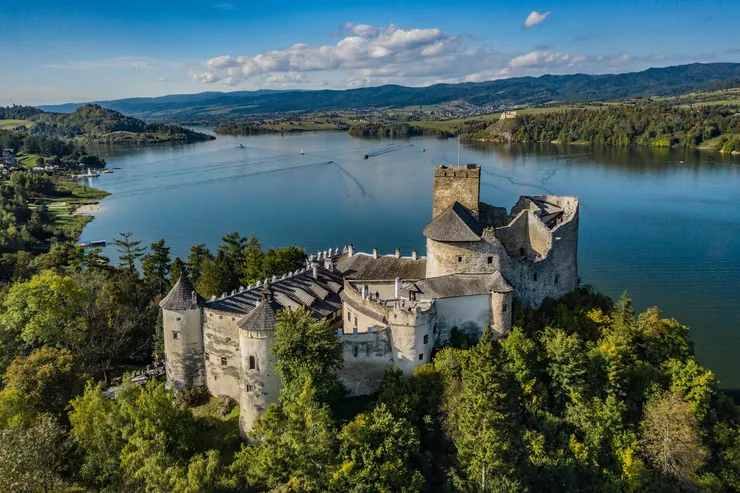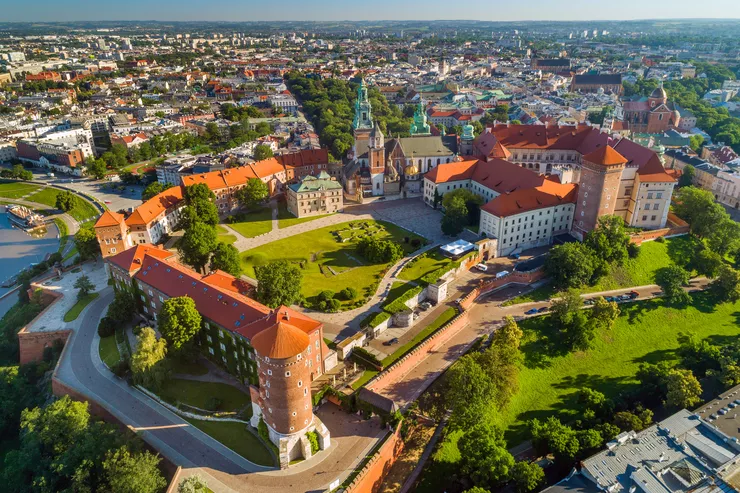





Homes to the Kings and Knights of Yore (and one Dragon).
Were castles really what popular culture makes them? The grandest were symbols of power, and places of ostensible splendour and considerable comfort, yet many of the lesser ones were just watchtowers guarding major trading routes, where none of these were available. In times of trouble, they all provided places of refuge.

For castle explorers, Małopolska is a perfect place to start or continue a journey of experience. The region boasts all types of castles, from the mighty Wawel that used to reign over a kingdom spanning a quarter of Europe from the Black to the Baltic Sea, to the ruins of small watchtowers along what is known as the Trail of Eagles’ Nests. What they all have in common are the captivating stories known to local aficionados and guides, which will undoubtedly enrich your experience.
Wawel, standing proudly over the Royal Capital City of Kraków, is the symbol of Polishness, and was so also in the times when Poland was wiped from the maps of Europe. Most of it was built in the heyday of the Kingdom of Poland. Even during the kingdom’s decline and with the royal court relocated downstream the Vistula, Wawel remained the place of royal coronations and burials. This is where you can admire the royal chambers, insignia, treasuries, and armoury among architecture that survived the Second World War undamaged.
It is no surprise that when one of the kings, named Great by the way, commissioned a major castle on the Trail of Eagles’ Nests, it was made to resemble Wawel. And like its royal cousin, the Castle in Pieskowa Skała was remodelled in the Renaissance. Today, it attracts not only with its gardens and exhibitions in the chambers but also the beautiful views of the Jurassic valley it was built in. The area is uniquely beautiful, with jutting limestone rocks and cliffs. The castle itself is a gem on the Trail of Eagles’ Nests, a line of castles that in the 14th century guarded the western border of Poland and kept the roads safe for merchants. Other notable castles on the route include those in nearby Ojców, Bobolice, Korzkiew, Mirów, Ogrodzieniec – some are ruined, some have been rebuilt, all are worth a visit.
Speaking of safe trading routes, standing on two sides of the Dunajec River, turned a picturesque reservoir some decades ago, are two castles that used to guard the commercial route between Poland and Hungary. In the Middle Ages, the Dunajec Castle in Niedzica was bestowed by the King of Hungary of Hungarian lords, while Czorsztyn Castle standing on the other bank belonged to Polish magnates and was extended by the king. The two castles are well worth a day’s visit. The Niedzica Castle is beautifully preserved in its Renaissance form, which it acquired in the 16th century, while the Czorsztyn Castle presents a thought-provoking picturesque ruin.
Make sure you learn at least some of the tales, legends, and stories the castles of Małopolska are enshrouded with. They are truly fascinating. One of them explains the mystery of an Inca princess in Dunajec Castle in Niedzica, and prompts you where to look for her hidden treasure. All you need is to unravel the quipu message she left.
To tempt you to visit Małopolska, let me also add that our region boasts far more castles than the four described above. There are 25 of them only on the Trail of Eagles’ Nests that takes you along a 100-mile route officially considered Poland’s prime tourist trail.
The Cathedral standing on Wawel Hill next to Wawel Castle is as eclectic as you can imagine, sporting elements from all architectural styles, with the Sigismund Chapel being hailed the Pearl of Renaissance north of the Alps.
Not all the castles belonged to the king, many belonged to the magnates, and the bishops also had theirs. The one in Lipowiec, over the beautiful open-air Ethnographic Park in Wygiełzów was owned by bishops and doubled as a prison.
You can surprise many a Pole, telling them that the word “Wawel” comes from Celtic, and means “a hill among marshes”.
And the dragon? No, we have not forgotten about the dragon but we’ve saved him (her?) for the end. Look for the Wawel Dragon in front of the Dragon’s Den, and see it breathe real fire. The den itself features not only in local fantasy, as Neil Gaiman included it in The Graveyard Book.








